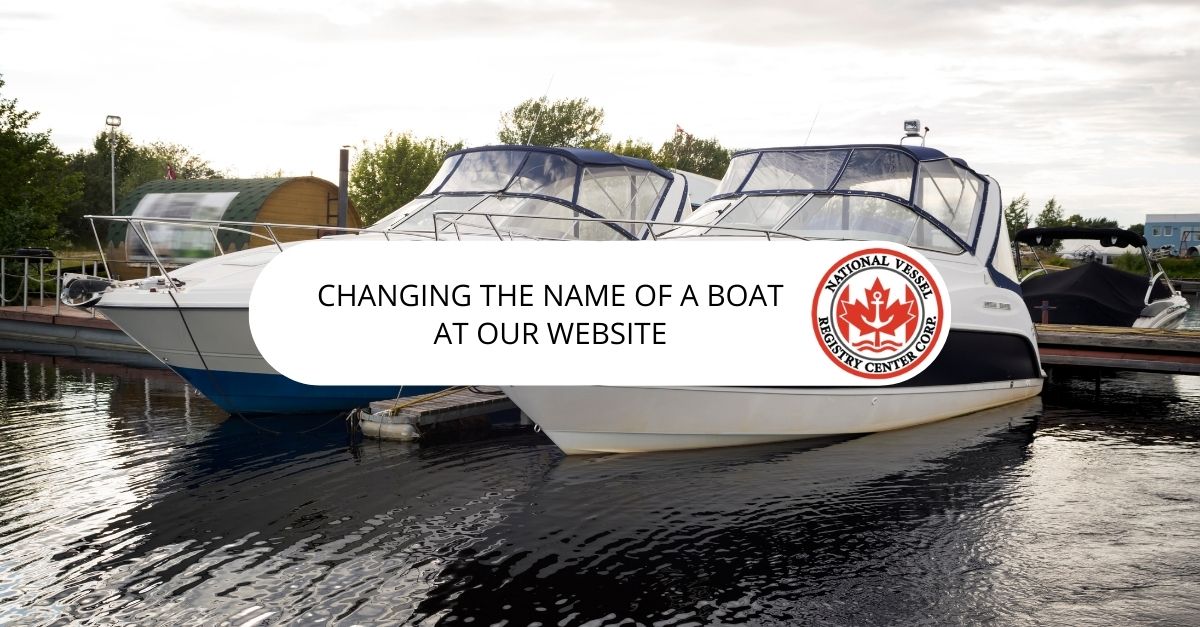We, at the Canadian Vessel Registry, make changing the name of a boat at our website a breeze. The hard part comes when you have to get rid of the old boat name on your vessel. Otherwise, you can make it official by visiting our website and completing the required documentation.
Changing the Name of a Boat Falls Under the Rules for Larger Vessels
Remember, changing the name of a boat is not required unless the vessel has been included under the Large Vessel Registry system, or your commercial boat or pleasure craft is at least 10 hp or 7.5 kw.
The application on our site is very user-friendly and will not take much time to complete. Whether you’re a company or individual, the form is pretty self-explanatory.
Selecting a Boat Name and Entering the Port of Registry
When you change the name of a boat, you’ll need to choose a new name like you do with a boat that has never been on the waters. It is important to identify your boat with a unique name and to enter a port of registry.
While the name can help identify you in case of an emergency, the port of registry represents the location where you must pay your registration fees and taxes. The boat also is subject to the laws in that locale, including Canada’s regulations.

How to Choose a Boat Name
The name you give your vessel should be easy to pronounce and remember. While you might like some longer, more creative names, they may not work in case of an emergency. Avoid using words that sound like distress signals, as well, such as SOS or Mayday.
Keep the name short and readable. Examples of suitable boat names include Cleopatra, Shore Thing, and Castaway. If you wish, you can reserve your new boat name for as long as a year. You can also extend the reservation after that time.
Filling Out the Name Change Application
To fill out the name change form, you’ll need to include the new name of your boat as well as the official number, the current name of the vessel, and contact details. Once your name change is processed, your next move will be to get rid of the old name and add the new name.
While a lot of superstition surrounds changing a boat’s name, you still have to do what you need to do. After all, you don’t want to navigate the waters with a name that is the same as an ex-spouse’s or a name that just does not fit your personality.
Make Sure the Old Name Is Completely Removed Outside and Inside the Boat
If need be, you’ll have to go through the rigors required to avoid the wrath of the sea god, Poseidon. To begin, you need to completely remove any markings of the old name. This means you need to get rid of any evidence of the name inside and outside the boat. Don’t leave any traces of the old boat’s name onboard or on the boat’s exterior.
Strike the old unwanted name from the logbook and all related documents. Better yet. burn any paperwork with the old name attached. Don’t take any item onboard featuring the new name until everything on the boat that shows the old name is removed.
Adding a New Name to the Boat’s Exterior
To add the new name to a pleasure craft, you’ll need to follow specific steps – all which Transport Canada requires legally, and a regulation that is part of TC’s blue book registration process.
The Name of a Pleasure Craft Goes on the Boat’s Transom in Clear and Distinct Lettering
According to TC, the name and port of anchorage should be presented on the side, toward the front of the boat so it is clearly seen on the exterior of the hull. The name and port of registration should feature lettering that is at least 4 inches or 10 centimeters tall.
Add the Name for a Commercial Boat on Either Side of the Bow
If you’re adding a commercial name, the lettering should be at least 4 inches tall and appear on either side of the boat’s bow above the water line. Include the name and place of anchorage on the transom on the stern.
Boat Purging and Renaming Ceremonies
Once you have your boat re-named, tradition calls for a purging ceremony. When you recite the oath to Poseidon, you’ll also want to have a metal ID that includes the old boat’s name with water-soluble ink. You’ll throw the tag in the water, after reciting the oath, over the boat’s bow.
You’ll also want to have champagne handy to dispense to Poseidon, getting rid of half of the libation, moving from east to west. All this precedes the renaming ceremony. During this activity, you’ll need to pour more champagne, plus two glasses- one for you and the boat’s mate. Pour the liquid over the boat – going from west to east.
Changing the Name of a Boat: Apply, Here, on Our Website Now
If you’re not superstitious, at least you need to remain compliant. Changing the name of a boat can be done easily on our website here at the Canadian Vessel Registry. We work in conjunction with Transport Canada to ensure that all name changes go through in a fast and timely manner.

